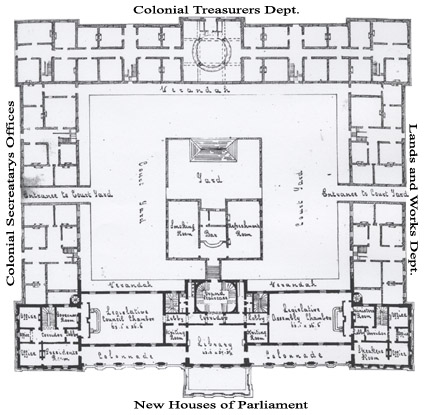-
Visit and learn
- Message from the Speaker
- About Us
- Visitors
- Visit the Public Gallery
- Visit our Gift Shop
- Have Your Say
- Get Involved
- Education and Learning
- History
- Heritage Collections
- Preservation of our Heritage
- Regional Sittings
- CPA Australia and Pacific Regional Conference
- Publications and Reports
- Speakers' Corner
- Opening of the 58th Parliament
- Parliamentary Annexe Reparation and Refurbishment
- Contact Us

Charles Tiffin
Tiffin contributed greatly to the quality of historical architecture throughout Queensland. Apart from designing Parliament House, he was also responsible for Old Government House, Customs House, the Old Ipswich Court House, the Lands Office, Sandy Cape Lighthouse, as well as several other buildings including churches and post offices around the state. Several projects were completed in his personal time.Born in Newcastle-Upon-Tyne, Northumberland, England in August 1833 to Robert Tiffin, a whip manufacturer, and his wife Jane Haig, Tiffin was their third son but the only one to survive infancy. Records indicate Tiffin was trained as an architect by John Edward Watson in his home town. In 1855, Tiffin emigrated to Victoria, working briefly in Geelong before forming a private practice with William Davidson, Tiffin and Davidson, in Hobart.
On 1 January 1857, Tiffin married Mary Anne Haig, the daughter of a prosperous Hobart merchant. Tiring of private practice and seeking a Government position, Tiffin was employed by the New South Wales Government as the clerk of works for the Moreton Bay settlement in 1857 following a recommendation from the New South Wales Colonial Architect Alexander Dawson. After the creation of the Colony of Queensland in 1859, Tiffin secured the post of Colonial Architect. As such, he was charged with the responsibility of providing accommodation for the new colony's bureaucracy, Governor and Parliament. Aged just 26 at this time, he took up the challenge, in his own words, as a young, active, zealous, self-reliant man.
In July 1860, he moved to his farm, Darrama, on Breakfast Creek, which had an extensive garden and pasture for stock. Besides his interest in farming, Tiffin was a man of intellectual accomplishment. According to the Ipswich Punch of November 1870, Tiffin was bearded like a bard, appeared older than his years and generally dressed in a suit of black. By 1859, he was a trustee of the Brisbane School of Arts in Adelaide Street, which at that time served a significant role in the newly-established colony as a library, a centre of political discussion and a hall for public meetings. This school is the precursor to the Queensland University of Technology. Tiffin gave occasional lectures at the school on art and architecture. Tiffin was also a founding Member of the Queensland Philosophical (later Royal) Society, serving on its council between 1863 and 1865, and remaining a member until his death in 1873. He delivered several papers to the society, one related to his invention of a self-earthing closet. Trialled at the Brisbane Hospital and Parliament in 1866, the closets were later manufactured commercially by local cabinet makers.
Tiffin took his Government duties seriously and is said to have worked tirelessly to design and construct more than 300 public buildings throughout the colony despite limited resources, vast distances and difficulty in securing reliable contractors. In December 1863, a competition for the design of a permanent Queensland Parliament was announced. Tiffin won first prize in April 1864, among great controversy and acrimony. Another design was initially favoured but was rejected on the basis of cost. Tiffin was accused of having input into the judging of the competition. So moved were the architects of Brisbane, in May 1864, eight local architects petitioned Parliament. Tiffin indignantly denied any wrongdoing, and contributed the 200 guineas prize money to the Ipswich Grammar School to set up a scholarship. Regardless, the controversy continued throughout the year resulting in a revised design by Tiffin eventually being chosen.
The title of Tiffin's office was changed in 1869 to Superintendent of Roads and Buildings when the Government attempted to cut expenditure by transferring the responsibility for roads and bridges in the southern part of the colony to his office. Tiffin inherited an administrative burden without any additional Government support. As a result, he was soon worn down by overwork. Adding to the burden, friction with the Minister for Works in 1870 resulted in Tiffin being accused of being extravagant, particularly in relation to the construction of Parliament House. Tiffin was required to report to Parliament on the issue. An unsavoury episode in February 1871 basically ended Tiffin's career in Queensland. He contributed an article to the Brisbane Courier defending demoralised public servants under the nom-de-plume “Road Overseer”. Unfortunately for Tiffin, he was identified and was suspended from office the next day. A wordy defence of his actions by Tiffin did not save him, but recognition was given of his 14 years service, and he was allowed to resign instead of being dismissed. Before this eventuated, Tiffin became ill and produced medical certificates proving he was suffering from nervous exhaustion, and was prematurely aged and debilitated, yet he was only 39 years old.
After a year's leave of absence in April 1872, he retired on medical grounds. Following medical advice to move to a cooler climate, Tiffin sold his home, Darrama. On route to Tasmania, he was delayed in Sydney by further illness. He died in Sydney on 9 January 1873 at the age of 40. An obituary said Tiffin had contributed the best years of his life to Queensland, and that he deserved a more fitting reward.
Tiffin's Plan
The details of the final design settled upon can be seen in the following sketch. They were reproduced in the 1867 Votes and Proceedings of the Queensland Legislative Assembly.
The plan combines Parliament House and public offices in a square formation around a central courtyard. The building was to be three storeys with the offices and reception rooms on the ground floor and the legislative chambers taking up most of the first and second floors of the George Street wing.
The other three wings were to house the Colonial Treasury, the Lands and Works Department and the Colonial Secretary.
This design is said to have been based on an ideology of colonial development where the close proximity of these significant departments in the colony's future growth would have been seen as advantageous. In addition, the design is similar to the arrangement of legislative and Government offices created during the restoration of the French Louvre in the 1800s. A similar design was proposed for the London Houses of Parliament and nearby Whitehall offices in 1857. This design, which was never constructed, was published in popular and widely-read magazines of the day including the Illustrated London News..
